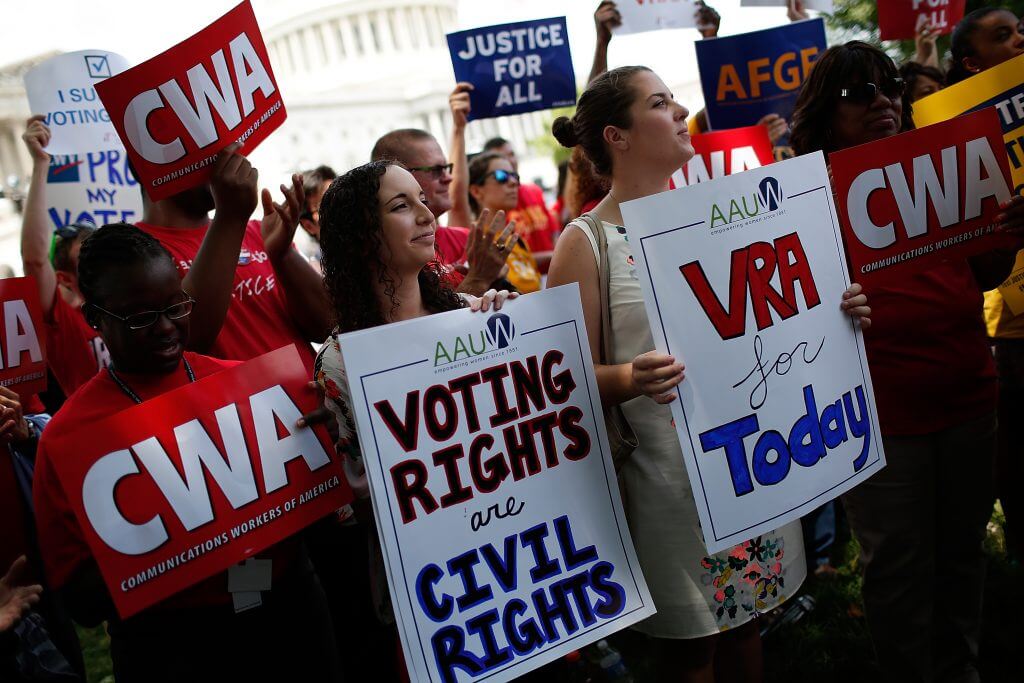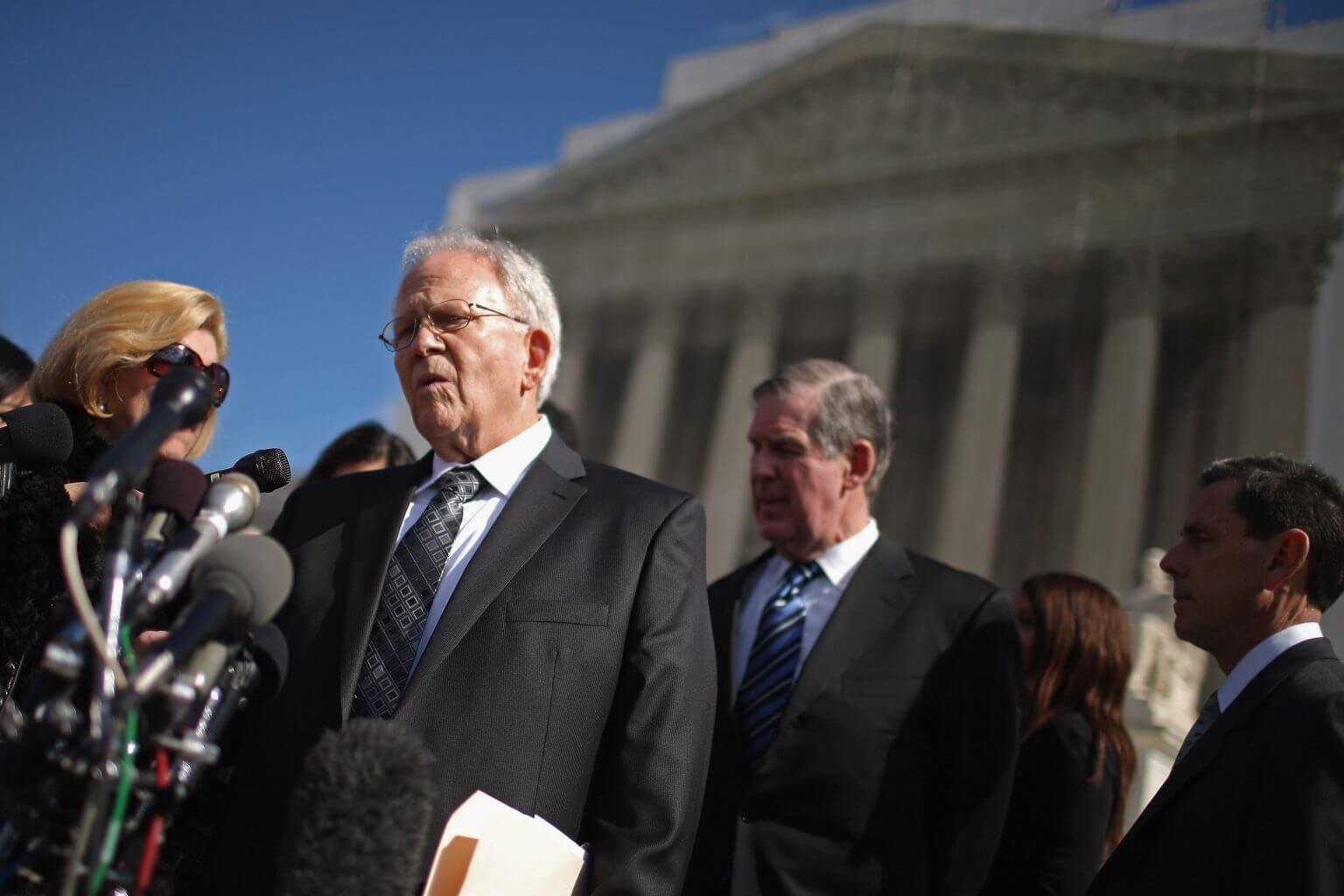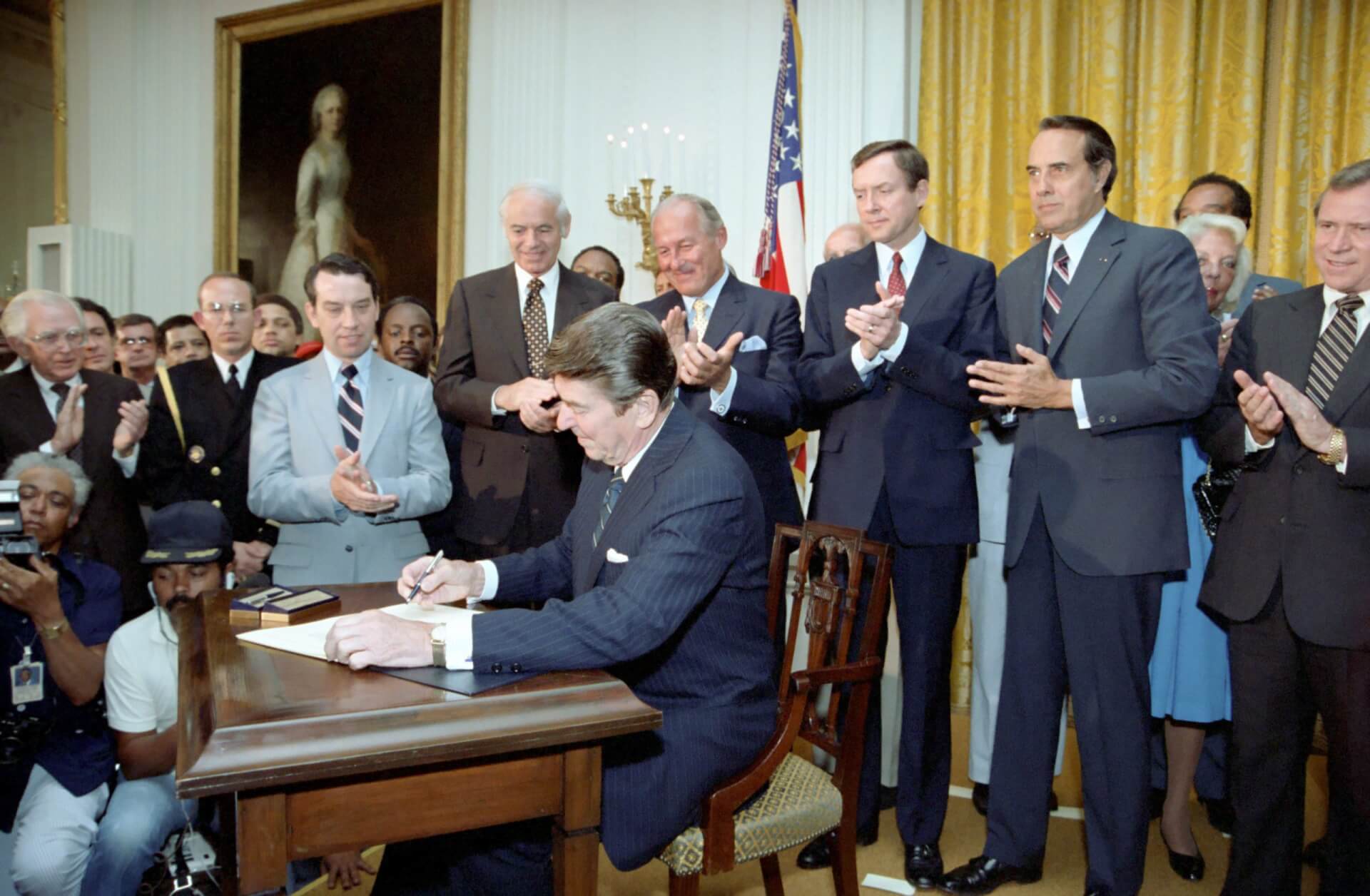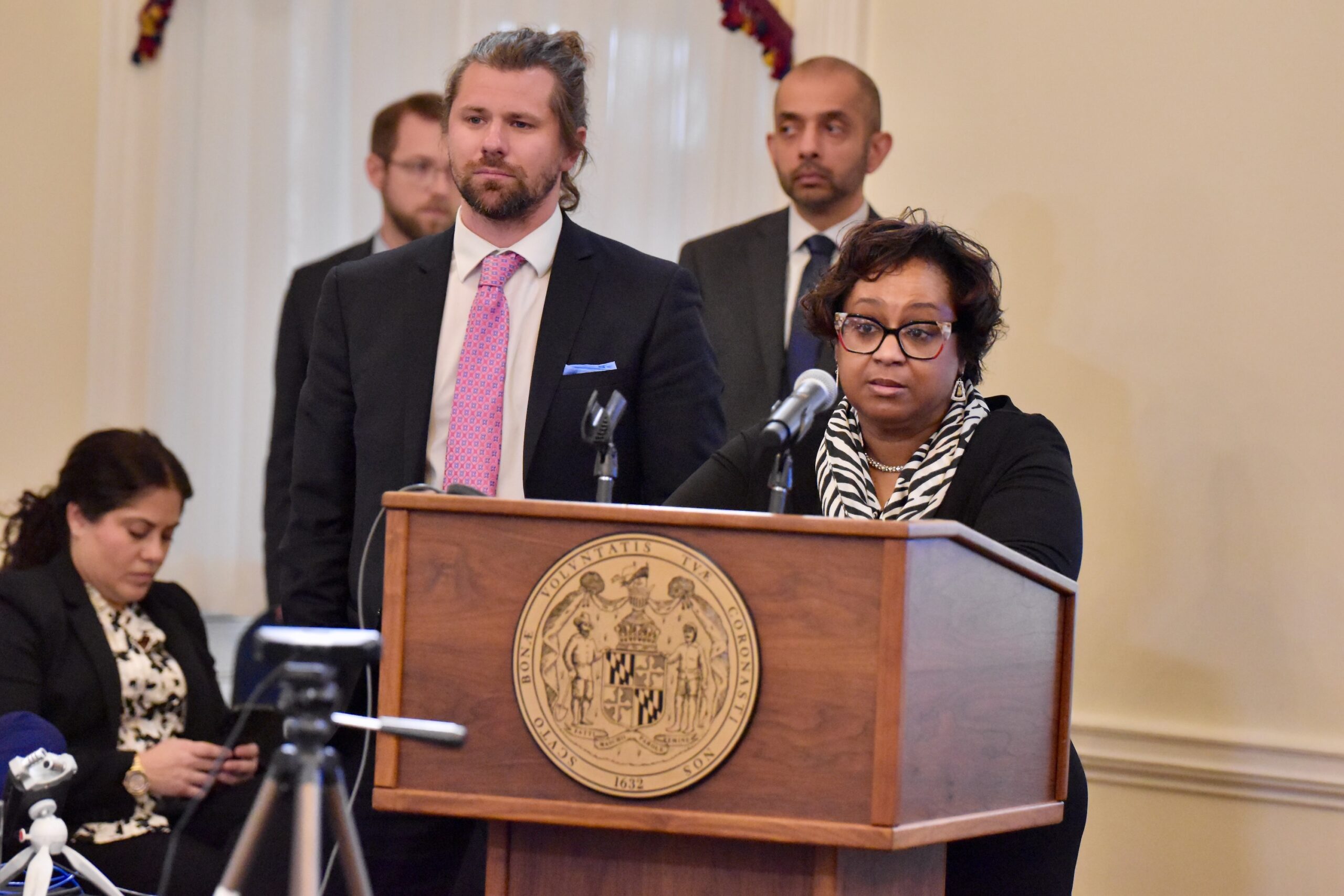Supreme Court Ruling on Voting Rights Act Opened Floodgates for New Restrictions


This is the third in a series of stories looking at voters’ concerns and voting issues in the 2020 election. Tomorrow: A look at purges to voter rolls.
It hadn’t even been a day since the U.S. Supreme Court dismantled one of the pillars of voting rights in America, and North Carolina lawmakers weren’t wasting any time.
Republican legislators had been contemplating a bill that would require photo identification to vote. The bill had plenty of support, but it had spent the past two months sitting in committee while lawmakers waited for the Supreme Court to determine whether the state could go much further.
North Carolina was among a handful of states that couldn’t change its election laws or procedures without approval from the U.S. Department of Justice. Preclearance, as the practice was known, was part of the Voting Rights Act of 1965, and applied only to a handful of states and counties deemed to have exceptionally troubling records when it came to disenfranchising minority voters.
On June 25, 2013, the Supreme Court gave North Carolina its answer. By a 5-4 decision, the court agreed with lawyers for Shelby County, Ala., and ruled that the formula the Voting Rights Act used to determine which jurisdictions needed preclearance was unconstitutional.
Had the Supreme Court’s ruling in Shelby County v. Holder gone the other way, North Carolina lawmakers could have passed the original photo ID bill. But with preclearance no longer a factor, North Carolina was free to pass whatever it wanted. And Republican lawmakers wanted to do much more.
Now, one lawmaker said, they could “go with the full bill,” referring to more extensive omnibus legislation lawmakers had planned on the contingency that they wouldn’t need preclearance.
North Carolina was far from alone. Across the country, states and local jurisdictions that were free from the Justice Department’s watchful eye were taking advantage of their new ability to restrict voting rights in ways that had been impossible for decades. And even in places that hadn’t been under preclearance, the Shelby County ruling sent a clear signal to policymakers about where the Supreme Court stood on voting rights.
The Supreme Court had gutted a pillar of the Voting Rights Act, and the door was wide open.
Retrogression
Section 2 of the Voting Rights Act, which prohibits voting practices or procedures that discriminate based on race, ethnicity, language or other minority status, applies to every state, county, city and other jurisdiction in the United States. For habitual bad actors, there was an extra layer of protection in Section 5 of the law.
Preclearance required states and other jurisdictions with histories of disenfranchising minorities to seek approval from the Department of Justice before implementing any changes to voting or election laws or procedures.
Under Section 2, anyone could sue over a discriminatory law that made it harder for minorities to vote. But litigation can drag on for years, leaving questionable election laws on the books for multiple election cycles. Section 5 preempted those changes and forced the government to prove that changes didn’t make it harder for minorities to exercise their right to vote.
The Justice Department would look at a number of things when it determined whether to preclear voting changes. Attorneys would investigate the rationale for the changes and analyze their effects on groups like people of color or language minorities. They’d speak with the affected communities to get their input on the effects of a change.
Justin Levitt, a law professor at Loyola Law School who previously worked as a deputy assistant attorney general in the department’s Civil Rights Division, described preclearance as an “early warning system.” One of the system’s biggest features was it forced states and local jurisdictions into a dialogue with the Justice Department about what would or wouldn’t receive approval, and then they could act accordingly, he said.
“It effectively notified decision-makers when a decision was about to take place and required the jurisdictions to compile the data to very specifically tell whether the change in question would have an adverse effect or not,” Levitt said.
If a change reduced minority voting strength or representation, the Justice Department would reject it. The term used for that reduction or dilution of minority voting rights is retrogression.
If the Department of Justice finds a law or other change was made with discriminatory intent, it would deny preclearance. Retrogression alone, even without discriminatory intent, was enough to mark a law for rejection.
Not all voting and election law changes are equal under the eyes of Section 5, even those that on their faces seem similar. For example, 35 states require some sort of identification to vote — North Carolina is the 36th, but the courts have temporarily enjoined its law — according to the National Conference of State Legislatures, and those laws vary from state to state.
Arizona voters in 2004, when the state was still under preclearance, approved laws requiring photo ID to cast a ballot and proof of citizenship to register to vote. Both received preclearance, though Arizona is one of nine states whose voter ID law is classified as “strict” by NCSL. The Supreme Court in 2013 ruled that Arizona can’t require proof of citizenship to vote in federal elections, but left the voter ID requirement in place for state and local elections.
Yet voter ID laws in other states have been the source of some of the fiercest post-preclearance litigation in America.
The act of requiring photo ID in itself wasn’t discriminatory under Section 5. Whether such requirements were discriminatory depended on other factors, such as what kinds of identification were acceptable for voting and who was likely to use them.
Gerald Hebert, an attorney who used to work in the voting section of the Justice Department’s civil rights division, pointed to Texas as an example.

Election law attorney Gerald Hebert. Campaign Legal Center photo.
Like North Carolina, Texas sprang into action virtually the moment the Supreme Court announced its decision, announcing that a photo ID law that had been blocked by a federal court would now go into effect.
Texas’s law prohibited forms of photo identification that minority voters were disproportionately likely to use, such as student IDs and state employee IDs, Hebert said. But it did allow forms of identification disproportionately used by white people.
For example, 91% of the people who have licenses to carry firearms in Texas were white. Texas’s law permitted the use of those IDs to vote, even though they were available to noncitizens, undermining GOP lawmakers’ rationale that the photo ID law was intended to prevent undocumented immigrants from voting.
The biggest losers
Most if not all states that were covered by Section 5 have taken advantage of their newfound freedom in the wake of the Shelby County ruling. Voting rights experts say three states — Georgia, North Carolina and Texas — stand out as the worst offenders.
“If there was a TV game show called the Biggest Losers when it comes to voting rights, those three states would win hands-down every time,” Hebert said.
Hebert pointed to North Carolina’s “full bill,” which he fought in court, as one of the most egregious examples.
The bill required photo ID for people to vote. It reduced the state’s early voting period from 17 to 10 days. It repealed laws allowing people to register to vote through election day and allowing teenagers to register if they would turn 18 by election day. And it barred election officials from counting provisional ballots cast in the wrong precinct.
The U.S. 4th Circuit Court of Appeals struck down the law in 2016, ruling that the North Carolina law’s provisions “target African Americans with almost surgical precision.” The findings were no different on the other provisions of the bill. The 4th Circuit noted that the legislature “requested data on the use, by race, of a number of voting practices,” and then used that data to restrict voting rights in five ways that disproportionately affected African Americans.
Hebert said Georgia’s controversial purge of hundreds of thousands of people from the state’s voter rolls in 2017, including more than 100,000 who were removed for not voting in previous elections, likely would not have survived scrutiny from the Justice Department as well.
In 2011, the Arizona legislature approved a law that would have required people who collect and turn in other voters’ early ballots to register with the state. But the Justice Department quickly signaled that a rejection might be in the works, and the state withdrew its application for preclearance rather than risk denial.
Five years later, with preclearance no longer an issue, Arizona banned third-party ballot collection, which critics dub “ballot harvesting,” outright.
State Sen. Martin Quezada, a Democrat from the Phoenix suburb of Glendale, said many voters in his working-class, heavily Latino district miss the deadline to mail in their early ballots and don’t have time to take them to a polling place or voting center because of the demands of their jobs. So campaigns and advocacy groups will go to voters’ homes to collect ballots and turn them in.
“That was done really as a response to what happened in my part of the state, in District 29, where we had amazing volunteer efforts to help people vote,” Quezada said.
After two years of litigation, the U.S. 9th Circuit Court of Appeals struck down the law, in part, as a violation of Section 2 of the Voting Rights Act, finding that the law had a discriminatory effect on Latino and Native American voters, and that it was designed to do so. The 9th Circuit also noted that the state had to withdraw the preclearance application for the previous bill — one of only six times the state did so out of 773 total applications — and took note of the state’s “unsuccessful efforts to enact less restrictive versions of the same law when preclearance was a threat.”
Arizona’s attorney general, a Republican, appealed the 9th Circuit’s ruling to the Supreme Court, which allowed the law to go into effect before the 2016 election after the 9th Circuit blocked its enforcement.

Shelby County, Ala., attorney Butch Ellis talks to reporters outside of the U.S. Supreme Court February 27, 2013 in Washington, D.C. The court heard oral arguments in Shelby County v. Holder, a legal challenge to Section 5 of the Voting Rights Act. Photo by Chip Somodevilla/Getty Images.
In 2013, shortly before the Supreme Court handed down its ruling in Shelby County, then-Virginia Gov. Bob McDonnell, a Republican, signed a GOP-backed photo ID law in 2013. Opponents sued, but a federal appeals court upheld the law in 2016, finding no basis to conclude it was racially discriminatory.
Virginia’s General Assembly, now controlled by Democrats, voted to repeal the photo ID law this year, and Gov. Ralph Northam, also a Democrat, signed the bill.
“Literally every state that was previously covered by the preclearance provisions, every state has enacted laws that made minorities worse off,” Hebert said.
Section 2 has been an effective tool in striking down discriminatory laws. But while preclearance was a quick and pre-emptive process, litigation under Section 2 can be a lengthy process, as well as an expensive one for plaintiffs who must foot the bill for their own lawsuits rather than relying on the Justice Department to take action.
Parts of North Carolina’s initial post-preclearance legislation spent eight years in the courts before ultimately being struck down in 2019. In the meantime, the lawmakers elected under those laws got to spend years making policy.
“That’s justice denied because that is unquestionably justice delayed,” Levitt said.
Under Section 5, the Justice Department had 60 days to determine whether a law or voting change resulted in retrogression. Any law with discriminatory intent or effect would be rejected quickly.
In the post-preclearance world, it takes years. That not only makes it easier for policymakers to restrict minority voting rights; it incentivizes doing it as close to an election as possible so opponents have little time to go to court and get an injunction.
Some observers believe the Shelby County ruling has also caused kind of a ripple effect in places that weren’t subject to preclearance. Levitt said major litigation in states like North Carolina and Texas has left fewer resources for voting rights enforcement elsewhere.
Hebert and Bruce Adelson, who helped enforce preclearance as an attorney with the Justice Department, said the ruling showed the Supreme Court under Chief Justice John Roberts is hostile to voting rights, and inadvertently encouraged states and jurisdictions, even those that weren’t under preclearance, to act accordingly.
Hebert pointed to a massive voter purge in Ohio that the Supreme Court upheld last year and a 2019 law restricting voter registration activities in Tennessee, which faces a lawsuit that Hebert is part of. He wouldn’t go as far as to say Shelby County convinced the states to take such actions, but said states understand that the Supreme Court is sympathetic and is largely hostile to voting rights. Adelson noted that a recent U.S. 5th Circuit Court of Appeals rejected allegations of a Section 2 violation, citing Roberts’ opinion in Shelby County as its rationale.
“I do think that the decision to strike down the most effective civil rights law in the history of our country, the Voting Rights Act, in particular preclearance, sends an ominous signal throughout the nation that the Roberts court is going to not be a guardian of the voting rights of Americans,” Hebert said.
All politics is local
While statewide legislation and redistricting plans have generated the most high-profile legal battles in post-preclearance America, it’s at the local level, in counties, school board districts and in other special districts, where the effects of Shelby County are often most keenly felt.
“Most of the changes I’ve seen that really made me think, ‘Man, that would’ve been a really difficult submission,’ involve polling places, reductions in polling places, establishment of voting centers, all early voting, voting hours,” Adelson said.
That’s been the case in Georgia, where 214 polling places have closed since 2012. Bryan Sells, an Atlanta lawyer who specializes in voting rights, said polling place closures have been the biggest problem Georgia has faced as a result of the Shelby County ruling. Those closures are made without regard for the effects they’ll have on minority voters, Sells said, and there’s usually no way to know it’s even happening without attending the board of elections meetings where the decisions are made.
“Now those kinds of changes happen in the dark, literally in a meeting room with nobody else there,” Sells said. “It’s the kind of change that’s the greatest risk for making things worse for minority voters, the kind of change that nobody knows about.”
In Florida, only five counties were subject to preclearance — Collier, Hardee, Hendry, Hillsborough and Monroe.
Each of those five counties have seen fluctuations in the numbers of polling places since 2013. Hardee, with about 28,000 residents, held steady at 12 polling places between 2010 and 2014 but was down to 10 in 2018, according to state elections data. In Hillsborough, which contains Tampa, the differences were less stark, from 292 polling places in 2010 to 279 in 2014 and 275 in 2018.
But there have been fluctuations in non-preclearance counties as well. Miami-Dade, for example, swung from 541 in 2010 to 812 in 2014 to 574 in 2018. Duval County stood up 250 sites in 2010, 177 in 2014, and 196 in 2018.
Jorge Vasquez, director of the Power and Democracy Program of the Advancement Project, a multi-ethnic civil rights organization, said there has been a broader loosening of protections for minority voters statewide since the end of preclearance.
“In giving counties discretion, we’ve seen that the discretion has had an inverse impact on the Black and brown voters,” Vasquez said.
Maricopa County, Ariz., a county of 4 million people that’s home to the Phoenix metropolitan area, made national news in March 2016 when voters were left standing in lines for more than five hours in some cases for the state’s presidential primary. The fiasco was caused by the county’s decision to reduce the number of polling places from around 200 to 60.
Some voting rights experts, such as Adelson and Hebert, attributed the problem directly to the lack of preclearance, which likely would have precluded such a drastic reduction in polling places.
In Pima County in southern Arizona, home to Tucson, the Democratic county recorder in 2018 shuttered the lone early voting location on the Pascua Yaqui reservation. The tribe has spent two years trying to get the voting site restored, and in September the county’s Board of Supervisors voted to authorize a new voting site as a replacement. But the supervisors can’t force the recorder to open it, and she says it’s too late to make the change.
“Because tribal people don’t have the same access to mail, if you reduce in-person early voting you’re reducing opportunities for … tribal members to participate,” said Patricia Ferguson, the faculty director of Arizona State University’s Indian Legal Program and the director of the schools Indian Legal Clinic.
Elsewhere in Arizona, which has more reservation territory than any other state in the country, Native American voters have fared better. In the northwest part of the state, which is largely comprised of the sprawling Navajo Nation, Ferguson said county election officials haven’t moved or closed polling places in ways that would disadvantage Native American voters.
In North Carolina, county election boards in Forsyth and Pasquotank counties, both home to historically black colleges and universities, closed early voting sites on college campuses. Pasquotank was one of the state’s 40 counties that were under the preclearance requirements. Other counties, some of which were subject to Section 5 and some of which weren’t, limited early voting hours and voting sites on college campuses.
Special districts for things like school boards, community colleges and utilities were another area where preclearance prevented discriminatory practices at the local level.
At-large voting, in which voters in an entire city, county or other jurisdiction select representatives instead of voting district by district, was long a red flag for the Justice Department as a way to disenfranchise minority voters.
For the first time, African Americans in 2010 won the majority of the seats in the Sumter County School Board in south Georgia, which is about half Black and half white. A year later, Georgia’s legislature responded by adding two new at-large seats to the school board. The Justice Department denied preclearance to the law, but the legislature reinstated them in 2014 after the Shelby County ruling. A legal challenge to the change is still pending.
The Arizona legislature in 2010 added two at-large seats to the five-person Maricopa County Community College District. The at-large districts were intended to help drown out two troublesome board members. But some critics worried that the at-large seats would disenfranchise Latino voters, and when the Justice Department signalled that it might reject the law, the Arizona Attorney General’s Office withdrew its application for preclearance.
The unenforced law was still on the books in 2013 when the Shelby County ruling came down, allowing the at-large districts to go into effect.
Just because an entire state wasn’t covered by preclearance doesn’t mean statewide changes didn’t need Justice Department approval. North Carolina, for example, wasn’t covered statewide, but 40 of its 100 counties were, which ultimately required preclearance for any statewide changes.
Not every previously covered jurisdiction has used the absence of preclearance to tamp down on minority voting rights. Some have gone in the other direction.
Two townships in Michigan with large numbers of Spanish-speaking residents had been covered by Section 5. But Michigan has seen an expansion, rather than a contraction, in voting rights since the Shelby County decision. In 2018, voters approved an amendment to Michigan’s constitution that enacted automatic voter registration when people renew their driver’s licenses, allows same-day voter registration up through election days, permits absentee voting without a reason, and reinstated straight-ticket voting that Republican lawmakers had eliminated.
The test to come
The changes that Shelby County has permitted may pale in comparison to the test that’s coming next year — redistricting, which Adelson called the Justice Department’s “red alert” issue when Section 5 was in effect.
For some previously covered states, 2021 will mark the first redistricting since the end of preclearance. And those who are watching closely to see how minority voters will fare under the new congressional and legislative districts are concerned.
“This is uncharted voting territory, in a sense. It’s the first time without Section 5 in a long time,” Adelson said.
Other previously covered states decided not to wait for the decennial redistricting process following the 2020 Census to start redrawing district lines, giving a preview of what may be coming next year.
Georgia’s Republican-controlled Legislature took advantage of preclearance’s demise to engage in some mid-decade redistricting. After two white Republican state legislators in districts with growing minority populations barely won re-election in 2014, their colleagues in the General Assembly performed a mid-cycle redrawing to swap out heavily Black and Latino areas in their suburban Atlanta districts.
In Texas, officials in Galveston County almost immediately redrew the districts that elected justices of the peace in a way that eliminated predominantly Latino districts. A lawsuit over the districts is still ongoing. That same year, the Houston suburb of Pasadena eliminated two seats from heavily Latino areas and replaced them with at-large seats dominated by white voters.
An unenforced Louisiana law from 2010 that never received preclearance went into effect after the Shelby County ruling that allowed the Iberville Parish School Board near Baton Rouge to redraw its district boundaries, going from 13 members to eight districts and one at-large seat.
“What I’m worried about most is that in order to now invalidate discriminatory redistricting plans, we’re going to have to go to court, and it’s very costly, it’s very time consuming. A lot of groups don’t have the kind of resources necessary to litigate those,” Hebert said.
Levitt said one of the most valuable services that preclearance provided was to push back against incumbents protecting their own districts. Without preclearance, he worries what will happen next year when legislatures in previously covered states redraw their congressional and legislative districts.
“I am very afraid that when all the knives come out at once, we don’t have the tools to make sure that we are amply defended against the exceedingly powerful incumbent incentive,” Levitt said.
Even in states where lawmakers don’t get to draw their own districts, preclearance protected minority voting rights in the redistricting process. Arizona is among the small handful of states that use independent commissioners for redistricting. And in 2002, the Justice Department partially rejected its first commission-drawn legislative map. The maps drawn by Arizona’s second redistricting commission in 2011 were the first to receive preclearance on the first try since the Justice Department added it to the preclearance list in 1974.
With preclearance gone and Republicans expected by some to hold an advantage on the next Arizona Independent Redistricting Commission, some worry that Latino representation will suffer under the next maps.
And while it can be difficult to challenge a statewide redistricting plan in court, it’s harder to track changes in tens of thousands of local jurisdictions. When it comes to local redistricting plans, where officials can be just as determined to protect their incumbency as any state legislator, Levitt said it’s often difficult to know where to fight.
Gone, but not forgotten
Absent any federal action to restore the preclearance requirement, some states are moving to protect minority voting rights.
The newly minted Democratic majority in Virginia’s General Assembly is contemplating a state-level preclearance requirement. A bill introduced in the 2020 legislative session would have required certain cities and counties to convince the courts or Virginia’s attorney general that local election changes wouldn’t have a racially disparate impact. The proposal passed both legislative chambers, but failed late in the session as lawmakers tried to work out minor differences.
The bill’s main patron, Del. Schuyler VanValkenburg (D), said he intends to bring it back in 2021, saying it’s important for localities to think about racial impacts even if there’s no discriminatory intent.
“We want them to have to take these things into consideration,” VanValkenburg said. “Because when they don’t, we see that minority voters are often the first ones disenfranchised.”
Some voting rights experts are hopeful that federal preclearance can make a comeback as well.
Technically, the Supreme Court only struck down the formula used to determine which jurisdictions needed preclearance. It was Section 4, which contained that formula, not Section 5, which mandated preclearance for bad actors, that the high court found to be unconstitutional.
That means Congress can re-authorize preclearance under a new formula — or at least it can if the House of Representatives, Senate and White House all agree.
Thus far, that has been far from a reality. In previous years, Republicans were overwhelmingly supportive of the Voting Rights Act. The most recent reauthorization of the Voting Rights Act occurred in 2006, with most House Republicans voting for renewal and the Senate approving it unanimously.

President Reagan signing Voting Rights Act legislation in the East Room of the White House on June 29, 1982. National Archives from Collection: Reagan White House Photographs
More recently, however, the GOP has been hostile to the idea of reconstituting the preclearance requirement. Republicans controlled the House of Representatives at the time of Shelby County, and have since taken the Senate and White House, though the House is back in Democratic hands as of 2019.
The House in December passed legislation that would restore preclearance and update the criteria used to determine which jurisdictions need Justice Department approval. After longtime Georgia congressman and civil rights icon John Lewis died in July, House Democrats moved to rename the John R. Lewis Voting Rights Act of 2020. Lewis and other civil rights marchers were brutally beaten by state troopers on the Edmund Pettus Bridge in Selma, Ala., during a 1965 march for the original Voting Rights Act, and Democrats are pushing to pass the bill, which has little support from Republicans, in his honor.
Hebert is hopeful that, if former vice president Joe Biden defeats President Trump in November and the Democrats take control of the Senate, preclearance will once again become a reality next year.
What is Shelby v Holder?
Officials in Shelby County, Alabama, brought a federal lawsuit against the U.S. Justice Department and then-Attorney General Eric Holder in 2010, arguing that Section 4b and Section 5 of the Voting Rights Act were no longer needed. After lower courts ruled against them, the county appealed to the Supreme Court and won in a 5-4 ruling.
Chief Justice John Roberts wrote the majority opinion and said the coverage formula in section 4b used to determine which states were subject to preclearance was outdated, writing “the tests and devices that blocked ballot access have been forbidden nationwide for over 40 years.” He wrote: Nearly 50 years later, things have changed dramatically. Largely because of the Voting Rights Act.”
States subject to preclearance:
These are the jurisdictions that were previously required to get any legislation that would affect voting cleared before they could become law:
Alabama, Alaska, Arizona, Georgia, Louisiana, Mississippi, South Carolina, Texas and Virginia.
States where only some individual counties or townships were covered: California (three), Florida (five), Michigan (two), New York (three), North Carolina (40), South Dakota (two)
Jeremy Duda is associate editor of Arizona Mirror. Lisa Sorg of NC Policy Watch, John McCosh of the Georgia Recorder, Ken Coleman of the Michigan Advance, Michael Moline of the Florida Phoenix and Graham Moomaw of the Virginia Mercury contributed to this report.



 Creative Commons Attribution
Creative Commons Attribution